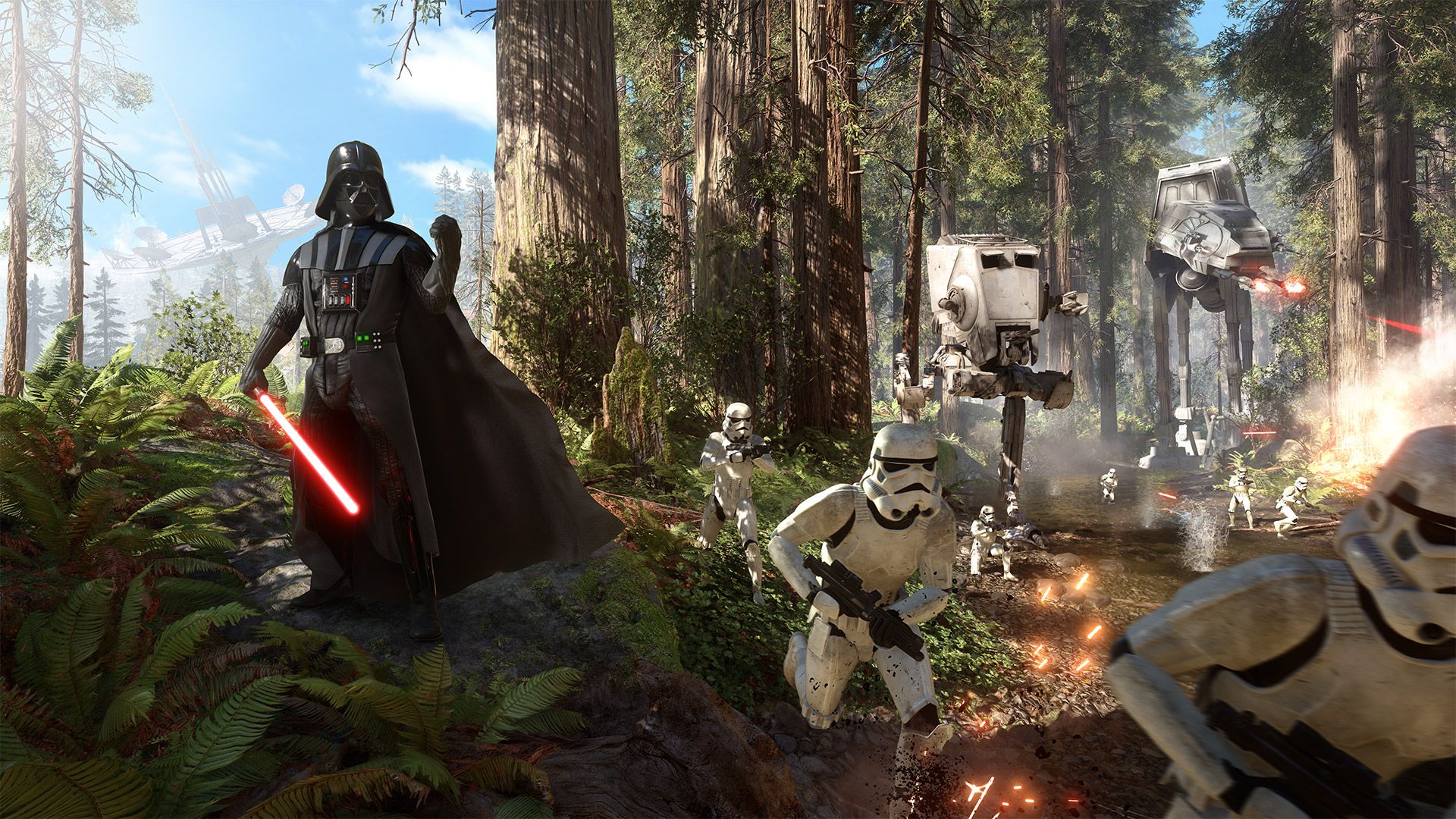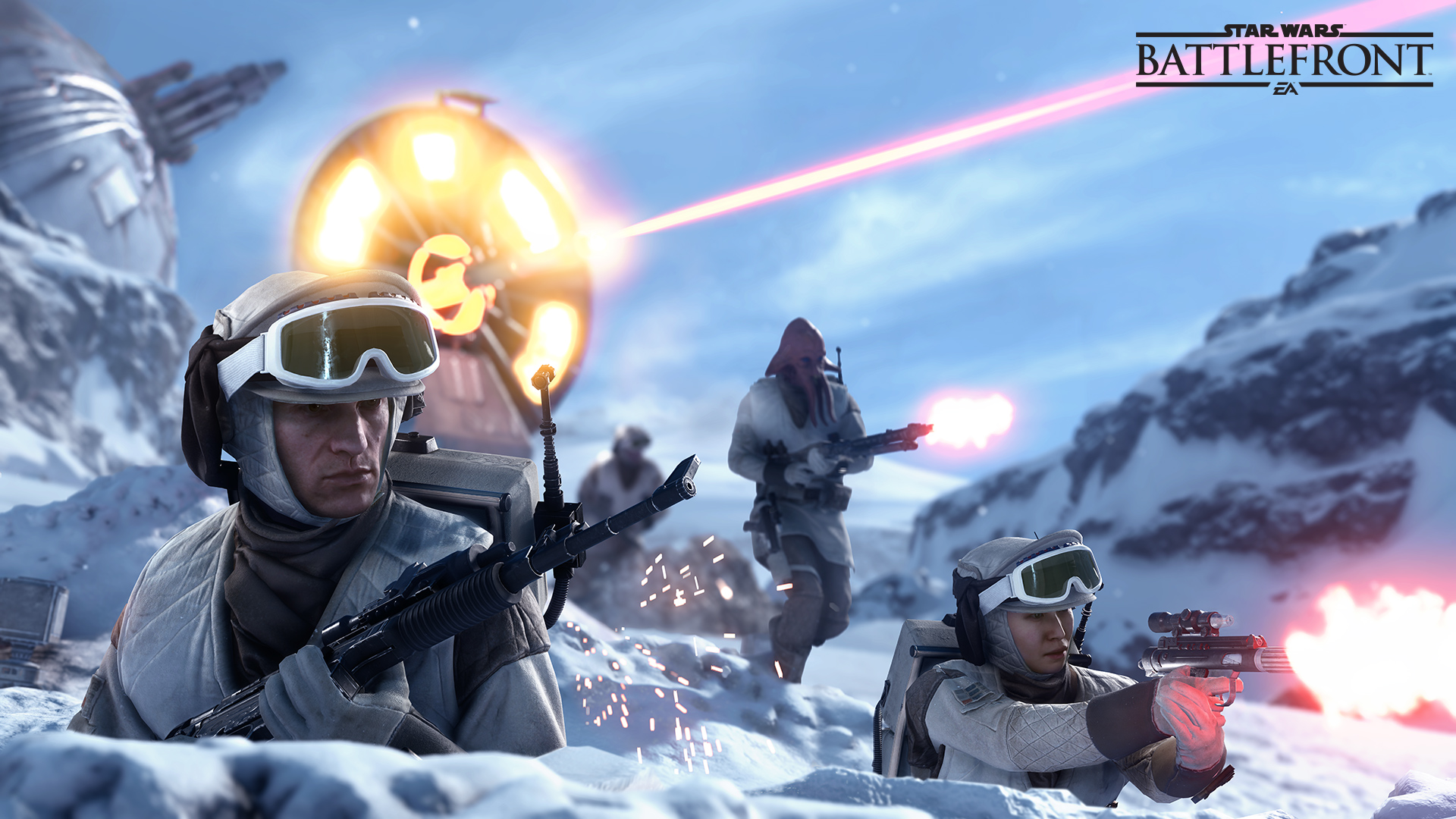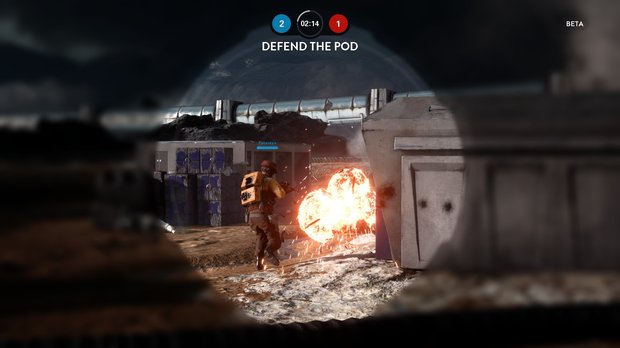Is Star Wars Battlefront's simplicity its greatest strength or biggest flaw?
I’d call DICE’s Star Wars: Battlefront an elegant FPS from a more civilised age, but the other day I flew a TIE Interceptor smack bang into an AT-AT walker, guiding it home with the gleeful abandon of a labrador jumping into a pile of leaves. Respawning near my partner, I activated my energy shield and galloped along the Alliance lines, treating Rebel scumbags to the brisk elbow of Imperial vengeance while they pecked away uselessly with their blasters. Then as I set off into the murky depths of Echo Base, who should I encounter but Mr Luke Skywalker himself, slicing and dicing whitehats as we ran for the uplink station. So I flash-fried him with one of those whooshy imploder things. Can’t parry a cloud of napalm, eh, young Skywalker? That’ll teach you to make a mess of your poor dad’s fascist pogroms, you Force-addled brat.

If Battlefront can’t be called an elegant game, it’s certainly a cheery blast from the past, though mileages have, of course, varied. Some adore DICE’s new shooter for its immediacy and throwback, vaguely cartoonish action, with relatively little auxiliary considerations to distract you from the gooey-eyed thrill that is running Darth Vader over in a Snowspeeder. Others resent it for the omission of features that are standard-issue in the Battlefield series - the ability to go prone, for example, or to board vehicles on the map rather than by way of a pick-up. Right now, I sympathise most with the argument that Battlefront is a breath of fresh air, floating across the cheerless coalface of the contemporary military shooter. But I suspect that the more I play, I might begin to align with those who feel that the game is a little too simple and unstructured for its own good.
At its best, the now-concluded Battlefront beta conjured up the ghost of Free Radical’s classic TimeSplitters series - tuned for hipfire, light on loadout optimisation, and relaxed to the point of recklessly indulgent about the use of explosives. There isn’t much of a penalty for shooting on the go, and while you can aim through a scope, doing so doesn’t confer the same enormous boost to your accuracy as in other games, so aggression is very much the focus. Cutting out the prone stance and reducing sniper rifles to a sparingly available secondary ability makes for noticeably less camping than in other shooters, though you can expect plenty of ragequit-inducing attrition around the main entrance to Echo Base on Hoth. The primaries, meanwhile, are sturdy all-rounders, effective at most ranges and, given an Ion charge, just as deadly against vehicles as on-foot targets. There’s rarely a situation in which you’ll flounder for want of a gun that can touch whatever it is that has you cornered.

Battlefront is a shooter you don’t have to think about too hard before you can start having fun. In other words, one whose beauties are manifest in the trenches rather than on the customisation screen. Abilities and items are snappily presented and it’s usually obvious which of them best suits the task at hand. If you’re defending Hoth, bring Ion grenades for use against those pesky Walkers. If you’re asserting the Emperor’s will, do so while rocking the aforementioned energy shield - it’ll protect you while you hack uplink terminals (or barge into Rebels like an angry goat). The on-map power-ups, finally, are refreshing not just because they steer the game even further away from dreary load-out tinkering - they also incentivise knowledge of the terrain, tugging players into the wrinkles of each layout. It’s a nice show of how a cunning multiplayer FPS developer can lay down routes without appearing to, daring you to quit your comfort zone in hopes of a tasty pick-up when the blaster bolts are flying.
For my money, the game is an initially irresistible mix of intuitive design and space age production values. But will it stand the test of time? One thing I’ve come to find annoying is the layout on Hoth, which veers at times from “easy to exploit” into “unbalanced”. While contesting the final pair of uplink points in particular, the importance of cover is dialled up the extent that the game stops being fun, with shielded turrets absolutely murderous in halfway-skilled hands. There’s also a mountain outside Echo Base that overlooks an uplink station, the route of an AT-AT and a fair few doorways and power-up spawn points - a regular camper’s daydream. Here’s hoping the other maps are more elegantly designed. And that DICE fixes the spawning on Hoth, which often fails to keep pace with the Imperial advance, coughing up squads of hapless Rebels right into the crosshairs of flanking Stormtroopers.

You could argue that a bit more tactical thinking is all that’s necessary to overcome inhospitable terrain, but that brings us to the other, bigger issue - though technically an army-on-army affair, Battlefront doesn’t seem to set much store by team-play. The partner system supposedly binds players together, but in practice your buddy is best treated as a roving spawn point tethered to a handy alternate loadout - operating in pairs doesn’t represent much of an advantage in a shooter that’s awash with splash damage, and rivalry over power-ups is a pressing reason to fight separately. The system makes more sense in smaller-scale modes like Drop Zone, but as regards Walker Assault, it feels at odds with the theme.
That’s powerfully apparent when fighting for the Rebels. It’s not enough to chip away at the Walkers when the opportunity presents itself - you’ll want to save up anti-vehicle gear as a group, and protect your heavy-hitters while they’re plugging away. Moments like these, reshaping the basic components of the combat with demands of greater team co-operation, show up how well Battlefront could straddle instant fun and more gratifying play. It’s just a shame the framework of the game doesn’t quite sell this level of coordination. Hopefully the other big objective-based modes and unlocks will layer strategy atop a shooter that, right now, devolves a bit too readily into lone wolf run-and-gun.
Weekly digests, tales from the communities you love, and more

In other games, we might crudely sum all of this up as a tension between “casual” and “hardcore” design. In this case, however, I think it’s more a question of the innocence of the Star Wars universe, pitched against the glowering militarisms of a Battlefield. For all the Empire’s penchant for uniforms and parades, the major spats in Star Wars are more like playground bouts of Cowboys and Indians than actual war. Death is theatrical, often comedic and gore-free. Nobody gets their head shot off from a kilometre away and nobody bleeds out. Stormtroopers aren’t black ops soldiers or Spartans - they’re mass-produced idiots who are never happier than when rushing into the crossfire.
And as for the Rebels - can you imagine Han Solo “watching his six” or suppressing a target? Perhaps - justifiably - aiming for a fan-pleasing Star Wars experience rather than purist’s shooter, DICE has embraced this childlike sensibility wholeheartedly, junking much of what holds its other FPS together in the process. The end result will doubtless turn out to be a great Christmas treat for people who like Star Wars (ie. pretty much everyone), but whether the essence of Star Wars can hold up a drawn-out campaign remains to be seen.



